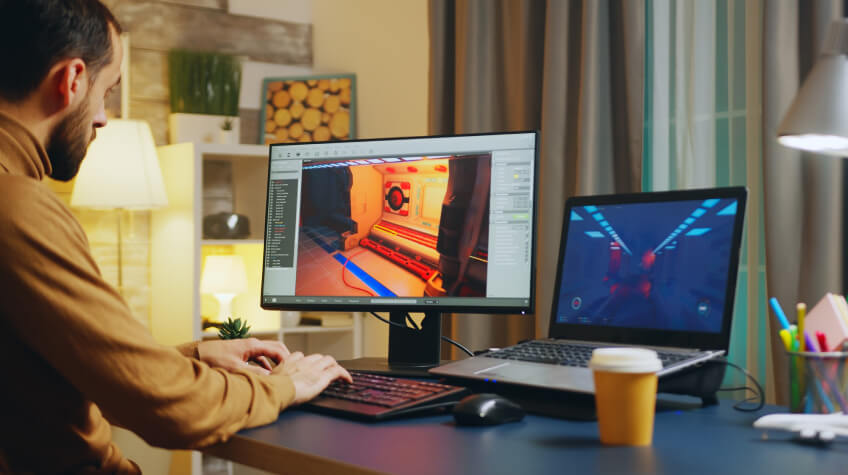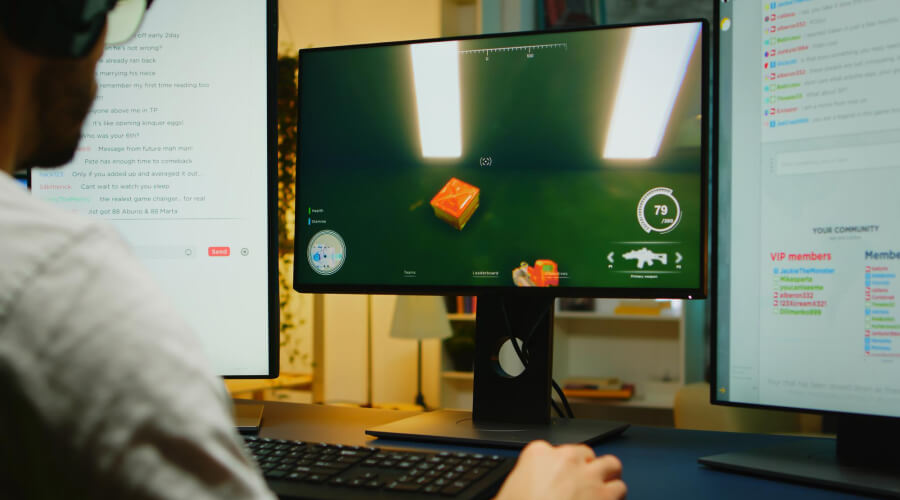
Welcome to “Creating Android Games Without Coding: A Simple Guide.” If you’ve ever aspired to forge your own Android game but found coding a daunting obstacle, this handbook is your gateway to unveiling the realm of game development.
You don’t require to be a coding expert to forge captivating games. We’ll acquaint you with the thrilling domain of no-code game development, where your creativity is boundless. In this succinct and novice-friendly article, we will escort you through each phase, from handpicking the ideal platform to unveiling your masterpiece on the Google Play Store. So, if you’re prepared to manifest your gaming concepts into reality, let’s plunge in and bring your dream game to life!
Understanding Game Development Basics
Game development encompasses a diverse process involving the conception, design, construction, and refinement of interactive digital games for various platforms, including computers, consoles, and mobile devices. It draws upon multiple fields, including coding, graphic design, sound engineering, and narrative craftsmanship, collaborating synergistically to craft captivating and immersive gaming adventures. At the core of game development lies the discipline of game design, where creators define a game’s rules, mechanics, goals, and overall architecture.
A well-crafted game design ensures equilibrium in gameplay, presents engaging challenges, and captivates players. Furthermore, game developers prioritize user experience (UX), striving to provide players with an intuitive, enjoyable, and visually pleasing journey within the game’s virtual world. An exceptional UX sustains player engagement and fosters the potential for long-term devotion, referrals, and a dedicated fan base for the developer’s creations. In summary, game development amalgamates artistry, technology, and storytelling, with game design and user experience as its essence and soul.
How to make game without coding
No-code or low-code game development represents a transformative approach that allows individuals to create games without traditional coding skills. In this innovative paradigm, game development is made accessible through visual interfaces, drag-and-drop components, and pre-built assets, enabling even non-programmers to design and build their games.
The advantages of no-code game development are manifold. First, it drastically reduces the barriers to entry, democratizing the game development industry and empowering a more diverse range of creators to bring their ideas to life. It accelerates the development process, fostering rapid prototyping and iteration, which is particularly advantageous for indie developers and small teams.
Furthermore, it minimizes development costs and risks associated with coding errors, making game creation more cost-effective. Ultimately, no-code game development opens new horizons for creativity, innovation, and experimentation in game design, making game development more inclusive and accessible for everyone.
Choosing the Right Game Development Platform
Introducing No-Code Game Development Platforms
No-code game development platforms have earned massive popularity due to their user-friendly interfaces and accessibility. This category includes the following standout choices:
- Unity (Visual Scripting): Unity’s Visual Scripting allows users to create games without traditional coding by visually connecting pre-made nodes and elements.
- GameMaker Studio: Known for its drag-and-drop functionality, GameMaker Studio caters to beginners and more experienced developers.
- Construct: Construct focuses on 2D game development and relies heavily on a visual event system for game logic.
- Unreal Engine (Blueprints): Unreal Engine offers Blueprint visual scripting, suitable for creating high-quality 3D games without extensive coding.
Selecting the Right Platform
Choosing best online platforms depends on your needs, skills, and project requirements. Evaluate aspects like ease of use, the type of game you want to create, available resources (tutorials, communities), and scalability. Beginners may find platforms like Construct or GameMaker Studio more approachable, while those looking for advanced 3D games might prefer Unity or Unreal Engine. Remember, the right platform enables you to bring your game concept to life effectively.
How to get started with your chosen platform
Starting with your chosen no-code game development platform is an exciting venture into the world of game creation. Here’s a step-by-step guide to help you set up your workspace:
- Platform Selection: Begin by selecting the no-code game development platform that best suits your game idea and skill level. Popular options include Unity (with visual scripting), GameMaker Studio, and Construct.
- Installation: Download and install the chosen software on your computer. Make sure to follow the installation instructions on the platform’s official website to ensure a successful setup.
- Account Creation: Making an account may be needed on some platforms. Register with a valid email address and keep your login credentials secure.
- Platform Familiarization: Take time to explore the platform’s user interface. Navigate through the menus, toolbars, and project settings to get comfortable with the layout.
- Tutorials and Documentation: Dive into the platform’s available tutorials and documentation. These resources offer valuable insights and step-by-step guides to help you get started.
- Project Creation: Start a new project within the software, naming it and specifying any initial project settings, such as screen resolution or platform compatibility (in this case, Android).
- Asset Management: Familiarize yourself with the platform’s asset management system. Learn how to import, organize, and use graphics, sound, and other assets in your game.
- Begin with Basics: Start with a simple project to grasp the fundamentals for your first Android game. Experiment with essential game elements like character movement, object interactions, and level design.
- Save and Backup: Regularly save your project and create a backup system.
These steps will prepare you to embark on your Android game development journey using your chosen no-code game development platform. Enjoy the creative process and the pleasure of getting your game concepts to life.
Creating Your First Android Game
Setting Up Your Development Environment
Embarking on your Android game development journey begins with setting up a conducive development environment. Here’s how to get started:
- Choose Your Tools: Select a no-code or low-code game development platform that aligns with your vision. Popular options include Unity (with visual scripting), GameMaker Studio, and Construct.
- Installation: Download and install your chosen software on your computer. Confirm you follow the installation instructions from the platform’s official website to ensure a smooth setup.
- Registration: It may be necessary to create an account on some platforms. Register with a valid email address, and safeguard your login credentials.
- Platform Familiarization: Take the time to explore the platform’s user interface. Familiarize yourself with the layout, tools, and menus through tutorials or sample projects.
- Project Creation: Start a new project within the software, giving it a suitable name and configuring initial settings, such as screen resolution and Android compatibility.
With your development environment set up, you’re poised to dip into the thrilling world of Android game creation.
Game Concept and Design

Having a clear game concept is fundamental to the success of any game development project. It serves as the blueprint for your game, guiding every aspect of its creation. A well-defined concept outlines the game’s genre, core mechanics, story (if applicable), and target audience. It helps you maintain focus throughout development, ensuring all game elements align with your vision.
Tips for Brainstorming Game Ideas:
- Identify Your Interests: Begin with your interests and desires. What types of games do you want to play? Your enthusiasm will shine through in your project.
- Research and Inspiration: Explore existing games, books, movies, or real-world experiences that inspire you. Borrow elements from these sources while adding your unique twist.
- Problem-Solving: Consider the challenges or problems your game could present to players. Engaging in gameplay often involves solving puzzles or overcoming obstacles.
- Audience Consideration: Consider your target audience’s age group and preferences. Tailor your game concept to appeal to them.
- Simple, Yet Unique: Sometimes, the most straightforward ideas can be captivating. Focus on creating a unique twist or mechanic within a clear concept.
Building the Game
Creating a simple Android game using a no-code platform involves several key steps:
- Project Setup: Open your chosen platform, create a new project, and configure settings such as screen resolution and aspect ratio for Android devices.
- Scene Design: Design your game’s scenes or levels by adding backgrounds, characters, and interactive objects. Arrange them to create your game environment.
- Game Logic: Use the platform’s visual scripting or logic system to define game rules and behavior. This may include character movement, collision detection, and win/lose conditions.
- Assets Integration: Import and integrate assets like images and sound effects into your game. These elements add visual and auditory appeal.
- Testing: Regularly test your game to identify and fix any issues or bugs. Debugging is a vital component of the procedure.
- Optimization: Optimize your game for Android devices, ensuring it looks good on a wide variety of screens.
- Exporting: Export your game as an APK file for Android devices.
Including step-by-step instructions and screenshots specific to your chosen platform is essential for effectively guiding users through these processes. This practical guidance makes it easier for beginners to follow along and create their own Android games.
Customizing and Polishing Your Game
Adding Graphics and Assets
Compelling graphics and sound effects are crucial for enhancing your game’s visual and auditory appeal. Here’s how to go about it:
- Finding Game Assets: Look for game assets on dedicated websites like itch.io, OpenGameArt, or the asset store of your chosen no-code platform. You can also create custom assets using graphic design software or hire artists if your budget allows.
- Importing Assets: Most no-code platforms have a simple process for importing assets. You can drag and drop images and sound files straight into your project. Organize them in folders to keep your project tidy.
Fine-Tuning Your Game
To enhance gameplay and user experience, consider these tips:
- Balanced Difficulty: Adjust the game’s difficulty curve to provide a gradual challenge. Players should sense a feeling of achievement as they progress.
- Feedback: Incorporate feedback mechanisms like sound cues, visual indicators, and messages to guide players and provide information about their progress.
- User Interface (UI): Ensure the user interface is intuitive and unobtrusive. Buttons and menus should be effortless to steer.
- Polish: Add polish to your game by refining animations, transitions, and special effects. Attention to detail can elevate the general experience.
- Performance Optimization: Continuously optimize your game for smooth performance, addressing any lag or loading issues that may arise.
By implementing these practices, you’ll enhance the quality of your game, making it more engaging and enjoyable for players.
Game Testing
Testing is a pivotal phase in game development, ensuring your game functions correctly and provides an enjoyable experience.
- Importance of Testing: Testing helps identify and rectify bugs, glitches, and gameplay issues. It ensures your game is stable, runs smoothly, and delivers a favorable user experience.
- Guidance on Testing: Play your game thoroughly, attempting various scenarios and interactions. Test it on different Android devices to ensure compatibility. Encourage friends or beta testers to playtest and provide feedback. Utilize debugging tools provided by your platform to identify and fix issues.
Publishing Your Android Game
Preparing for Publication
Preparing for publication is essential before sharing your Android game with the world. Here’s how:
- App Store Accounts: Begin by setting up developer accounts on the relevant app stores, such as the Google Play Store. This typically involves registering as a developer, agreeing to terms, and paying any associated fees.
- Requirements and Guidelines: Familiarize yourself with the app store’s requirements and guidelines. Each platform has specific criteria for game submissions, including content policies, age ratings, and technical specifications. Ensure your game complies with these rules to avoid rejection.
Uploading Your Game
Uploading your game to the app store is a significant milestone. Here’s a simplified walkthrough:
- App Store Console: Access your developer console on the chosen app store platform (e.g., Google Play Console). Create a new game listing.
- Game Information: Fill in essential information such as the title, description, screenshots, and promotional graphics. Set pricing, if applicable.
- APK Upload: Upload your Android Package (APK) file containing your game. Test your game on the store’s testing tracks to ensure it works as expected.
- App Store Review: Submit your game for review. The app store team will assess it for compliance with guidelines and policies. Be prepared to handle any problems or concerns they may raise.
Marketing Your Game
To get your Android game noticed, consider these marketing tips:
- App Store Listing: Craft an engaging and informative app store listing with high-quality screenshots, an appealing icon, and a compelling description highlighting your game’s unique features.
- Social Media: Promote your game on social media platforms, utilizing images, videos, and engaging posts. Engage with your audience and build a community around your game.
- Press Releases: Create press releases and contact gaming websites and influencers for potential reviews and coverage.
- Community Engagement: Interact with players, gather feedback, and implement improvements to keep your audience engaged.
- In-App Advertising: Consider in-app advertising or partnerships to increase your game’s visibility.
Effective marketing can significantly impact your game’s success by reaching a broader audience and driving downloads.
Conclusion
In this “Creating Android Games Without Coding: A Simple Guide,” we’ve embarked on a journey that has broken down the once seemingly insurmountable barriers of game development. By exploring the realm of no-code game development platforms, we’ve empowered aspiring game creators, regardless of their coding expertise, to transform their creative visions into interactive Android games.
We’ve covered the importance of a clear game concept, setting up your workspace, adding graphics, testing, fine-tuning, and ultimately, publishing and marketing your Android game. Through step-by-step guidance and insightful tips, we’ve paved the way for you to venture into this exciting world confidently.
Now, armed with newfound knowledge and boundless creativity, it’s your turn to craft captivating Android games and share them with the world. Let your imagination run wild, and your games shine bright, for the possibilities in this no-code era are limited only by your dreams and determination. Happy game-making!






